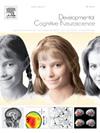电生理活动通过正字法意识预测儿童阅读能力:来自横断面和纵向研究的证据
IF 4.9
2区 医学
Q1 NEUROSCIENCES
引用次数: 0
摘要
大脑活动与阅读习得的关系是近年来研究的热点。在横断面和纵向研究中,我们旨在探讨静息状态和任务状态脑电生理活动是否以及如何预测儿童的阅读能力。在此,我们连续两年追踪73名小学生在休息和完成汉字识别任务时的正字法意识、阅读能力和脑电图信号。我们的分析显示,这些神经生理测量(θ / δ波段的脑电图功率和N170振幅)在横断面和纵向分析中都能显著预测正字法意识。中介分析表明,这些神经生理措施通过影响儿童的正字法意识来影响阅读能力。重要的是,年龄调节了这些影响:rs-EEG功率的预测作用在年龄较小的儿童中更强,随着年龄的增长而下降,而N170振幅的影响则相反,随着年龄的增长而变得更加突出。总的来说,这些发现表明儿童的阅读表现是由年龄敏感的大脑神经生理活动决定的,而正字法处理可能是一个关键的认知机制。本文章由计算机程序翻译,如有差异,请以英文原文为准。
Electrophysiological activity predicts children's reading ability through orthographic awareness: Evidence from a cross-sectional and longitudinal study
The relationship between brain activity and reading acquisition has been a research focus in recent years. In the current cross-sectional and longitudinal study, we aimed to investigate whether and how resting-state (rs) and task-state brain electrophysiological activity would predict children’s reading ability. Here, we tracked 73 primary school children’ orthographic awareness, reading ability, and EEG signals during both rest and completed a Chinese character recognition task over two consecutive years. Our analyses reveled these neurophysiological measures (rs-EEG power in theta/delta bands and N170 amplitude) significantly predicted orthographic awareness in both cross-sectional and longitudinal analyses. Mediation analysis revealed that these neurophysiological measures influenced reading ability by affecting children's orthographic awareness. Importantly, age moderated these effects: the predictive effect of rs-EEG power was stronger in younger children and decreased with age, whereas the effect of N170 amplitude showed the opposite pattern, becoming more prominent as age increased. Collectively, these findings indicate that children's reading performance is shaped by age-sensitive brain neurophysiological activity, with orthographic processing potentially serving as a key cognitive mechanism.
求助全文
通过发布文献求助,成功后即可免费获取论文全文。
去求助
来源期刊

Developmental Cognitive Neuroscience
NEUROSCIENCES-
CiteScore
7.60
自引率
10.60%
发文量
124
审稿时长
6-12 weeks
期刊介绍:
The journal publishes theoretical and research papers on cognitive brain development, from infancy through childhood and adolescence and into adulthood. It covers neurocognitive development and neurocognitive processing in both typical and atypical development, including social and affective aspects. Appropriate methodologies for the journal include, but are not limited to, functional neuroimaging (fMRI and MEG), electrophysiology (EEG and ERP), NIRS and transcranial magnetic stimulation, as well as other basic neuroscience approaches using cellular and animal models that directly address cognitive brain development, patient studies, case studies, post-mortem studies and pharmacological studies.
 求助内容:
求助内容: 应助结果提醒方式:
应助结果提醒方式:


